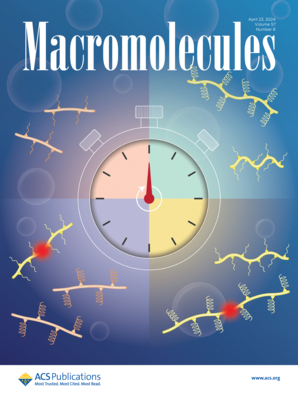Relaxation Dynamics of Poly(ethylene oxide)
IF 5.1
1区 化学
Q1 POLYMER SCIENCE
引用次数: 0
Abstract
Poly(ethylene oxide) is an important polymer with many applications, e.g., as solid-state electrolyte in batteries. Its relaxation dynamics, characterizing its molecular and submolecular motions, which is relevant for many of these applications, was investigated numerous times, mostly employing dielectric spectroscopy. However, the various dynamic processes revealed by these studies were interpreted in conflicting ways and even their nomenclature in literature is highly inconsistent. Here we present the results of a detailed investigation of this polymer employing dielectric spectroscopy covering a relatively broad frequency and temperature range. We clearly detect four intrinsic relaxation processes. The slowest one most likely represents a so-called normal mode, reflecting global motions of the polymer chains, an interpretation that was not considered in previous works. The second process can be unequivocally identified with the segmental α relaxation, which governs glassy freezing and the glass transition. The third, only rarely detected process corresponds to the Johari–Goldstein relaxation of poly(ethylene oxide), widely overlooked in previous studies. The fourth and fastest process is unrelated to the supercooled and glassy state of this polymer and probably due to local, intramolecular motions.

聚环氧乙烷弛豫动力学研究
聚环氧乙烷是一种重要的聚合物,具有许多用途,例如作为电池中的固态电解质。它的弛豫动力学,表征了它的分子和亚分子运动,这与许多这些应用有关,被研究了很多次,主要是使用介电光谱。然而,这些研究揭示的各种动态过程的解释方式相互矛盾,甚至在文献中的命名也高度不一致。在这里,我们提出了一个详细的研究结果,这种聚合物采用介电光谱覆盖相对较宽的频率和温度范围。我们清楚地发现了四个本征弛豫过程。最慢的一个很可能代表了所谓的正常模式,反映了聚合物链的整体运动,这种解释在以前的研究中没有被考虑过。第二个过程可以明确地与控制玻璃态冻结和玻璃化转变的节段α弛豫相一致。第三,很少检测到的过程对应于聚环氧乙烷的Johari-Goldstein弛豫,这在以前的研究中被广泛忽视。第四个也是最快的过程与这种聚合物的过冷和玻璃态无关,可能是由于局部的分子内运动。
本文章由计算机程序翻译,如有差异,请以英文原文为准。
求助全文
约1分钟内获得全文
求助全文
来源期刊

Macromolecules
工程技术-高分子科学
CiteScore
9.30
自引率
16.40%
发文量
942
审稿时长
2 months
期刊介绍:
Macromolecules publishes original, fundamental, and impactful research on all aspects of polymer science. Topics of interest include synthesis (e.g., controlled polymerizations, polymerization catalysis, post polymerization modification, new monomer structures and polymer architectures, and polymerization mechanisms/kinetics analysis); phase behavior, thermodynamics, dynamic, and ordering/disordering phenomena (e.g., self-assembly, gelation, crystallization, solution/melt/solid-state characteristics); structure and properties (e.g., mechanical and rheological properties, surface/interfacial characteristics, electronic and transport properties); new state of the art characterization (e.g., spectroscopy, scattering, microscopy, rheology), simulation (e.g., Monte Carlo, molecular dynamics, multi-scale/coarse-grained modeling), and theoretical methods. Renewable/sustainable polymers, polymer networks, responsive polymers, electro-, magneto- and opto-active macromolecules, inorganic polymers, charge-transporting polymers (ion-containing, semiconducting, and conducting), nanostructured polymers, and polymer composites are also of interest. Typical papers published in Macromolecules showcase important and innovative concepts, experimental methods/observations, and theoretical/computational approaches that demonstrate a fundamental advance in the understanding of polymers.
 求助内容:
求助内容: 应助结果提醒方式:
应助结果提醒方式:


